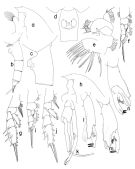|
|
 |
|
Calanoida ( Order ) |
|
|
|
Clausocalanoidea ( Superfamily ) |
|
|
|
Euchaetidae ( Family ) |
|
|
|
Paraeuchaeta ( Genus ) |
|
|
| |
Paraeuchaeta copleyae Park, 1995 (F,M) | |
| | | | | | | Ref.: | | | Park, 1994 (p.320); 1995 (p.39, Descr.F,M, figs.F,M) |  issued from : T. Park in Bull. Scripps Inst. Oceanogr. Univ. California, San Diego, 1995, 29. [p.136, Fig.26]. Female: a, forehead (left side); b, urosome (left); c, d, genital somite (left, ventral, respectively); e, Mx1 (first inner lobe separated), posterior; f, P1 (anterior); g, P2 (anterior). Nota: Similar in habitus to P. eltaninae but distinguishable from it and other related species. Laterally, rostrum with narrower base; its anterior side originating a short distance from suprafrontal sensilla. Genital somite elongate,; dorsal wall smoothly arched without noticeable hump; ventral margin of genital flange slightly emarginate or nearly straight, sloping in a posteroventral direction; posterior edge of genital field produced into a large lobe, ventral side of which roughly parallel to long axis of body; anterior margin of genital prominence nearly straight; posterior margin slightly bulging, gradually sloping and, together with posterior ventral wall of somite, forming a smooth curve. Cephalosomal appendages including setation of Mx1 as in P. eltaminae female. In P1 exopod, outer margins of first 2 segments not strongly sigmoid; outer spine of 2nd segment reaching base of outer spine of 3rd segment, which is a little more than 1/3 length of terminal spine. Male: h, forehead (left); i, P1 (anterior); j, P2 (anterior); k, P5 (anterior); l, distal exopodal segments of left 5th leg (anterior); m, idem (lateral, tilted clockwise); n, idem (medial). Nota: The serrated lamella of the left P5 resembles closely that of P. barbata but the digitiform process of the left P5 exopod is distally enlarged and rounded ibstead of tapering in a spiniform process as in the latter.
|
 Paraeuchaeta copleyae Paraeuchaeta copleyae Female: 1 - See key to species Groups and independent species of Paraeuchaeta (p.30): malayensis species Group. 2 - Outer spine of 2nd exopodal segment (or the 2nd of the first 2 exopodal segments forming a proximal, compound segment) of P1 normally developed (Fig.26-f). 3 - Outer lobe of Mx1 with 7 long setae in addition to 1 or 2 minute setae proximally (Fig.26-e). 4 - Genital somite without a conical process on left side close to anterior base of genital prominence (Fig.26-c). 5 - Dorsally and ventrally, genital somite symmetrical (Fig.26-d). 6 - Laterally, genital flange with normal posterior lobe (Fig.26-c). 7 - Laterally, genital somite with more or less smooth dorsal margin (Fig.26-c). 8 - Laterally, genital prominence with nearly straight or only slightly bulging posterior margin (Fig.28-c). 9 - Outer lobe of Mx1 with 7 long setae plus 1 or 2 very minute setae (Fig.26-e). 10 - Laterally, genital prominence with posterior margin equal to or longer than posterior ventral wall of somite (Fig.26-c). 11 - Laterally, posterior margin of genital prominence and posterior ventral wall of somite forming an angle of more than 140° (Fig.26-c). 12 - Laterally, genital prominence with posterior margin about as long as posterior ventral wall of somite (Fig.26-c). 13 - In P1 exopod, 2nd outer spine reaching base of 3rd outer spine (Fig.26-f). 14 - Laterally, posterior margin of genital prominence slightly bulging and poorly defined from posterior ventral wall of somite (Fig.26-c).
| | | | | Compl. Ref.: | | | Suarez-Morales & Gasca, 1998 a (p.109); Park & Ferrari, 2009 (p.143, Table 8, biogeography) | | | | NZ: | 1 | | |
|
Distribution map of Paraeuchaeta copleyae by geographical zones
|
| | | | Loc: | | | Gulf of California (Guaymas Basin)
Locality type: 27°00'N, 111°25'W. | | | | N: | 1 | | | | Lg.: | | | (3) F: 5,17-4,6; M: 4,72-4,28; {F: 4,60-5,17; M: 4,28-4,72} | | | | Rem.: | For Park (1995, p.40) the female is closely allied to P. eltaminae but can be distinguished from it by the shape of the dorsal wall of the genital somite, which in lateral view is only arched, and by the relatively well-developed outer spines of the 3rd exopodal segment of P2. In the male, the serrated lamella of left P5 exopod resembles closely that of P. barbata but the digitiform process is distally enlarged and rounded insetead of tapering in a spiniform process as in the latter.
Park (1995, p.39) found this new species in the Guaymas Basin hydrothermal vent field in the Gulf of California from 1930-1895 m at 27°00'N, 111°25'W, from 1940-1800 m at 26°59'N, 11°25'W, from 1894-1750 m at 27°00'N, 111°20'W and from 1600-1450 m at 26°59'N, 111°25'W. | | | Last update : 27/01/2015 | |
|
|
 Any use of this site for a publication will be mentioned with the following reference : Any use of this site for a publication will be mentioned with the following reference :
Razouls C., Desreumaux N., Kouwenberg J. and de Bovée F., 2005-2024. - Biodiversity of Marine Planktonic Copepods (morphology, geographical distribution and biological data). Sorbonne University, CNRS. Available at http://copepodes.obs-banyuls.fr/en [Accessed April 25, 2024] © copyright 2005-2024 Sorbonne University, CNRS
|
|
 |
 |




